Get the inside story of how Nike creatives escaped to Italy on a mission to craft Michael Jordan the most stylish performance shoe ever.
Rarely are sequels as good as the original.
In cinema, there are far more flops like Caddyshack II than triumphs like The Empire Strikes Back. And inside the offices of Nike in the mid-1980s, apparel execs began to think box office big when working on the secret successor to the original Air Jordan shoe.
Not only did this sequel sneaker need to hit at market — it needed a moniker worthy of its namesake superstar.
“The concern was, ‘Are we going to have an Air Jordan 1, an Air Jordan 2, an Air Jordan 3?’ Because the first shoe was just called Air Jordan,” Brad Johnson, former Nike Basketball Product Line Manager, told Boardroom. “Peter Moore or Rob Strasser were like, ‘Well, movie sequels don’t do so well when they call it Rocky II or Rocky III.’ So, if this is the original Air Jordan, where do we go from here?”

Having cast their headliner, Michael Jordan was already on board as the brand’s first signature hooper thanks to a $500,000 contract and $55 million worth of Air Jordan sales in 1985 alone. When it came to the sequel, every marketing move mattered regarding momentum and keeping their star satisfied — especially as he returned from a fractured foot.
“They knew Michael loved Adidas, so what if he goes to Adidas?” Johnson recalled. “It became apparent that we needed to take it in different directions, and the strategy evolved.”
The updated approach birthed a new brief: Imagination.
Flying out to Italy, a young Mark Parker and the brilliant Bruce Kilgore bet big on style and innovation for the eventual Air Jordan sophomore salvo.
Priced at an outlandish $100 and embossed in iguana hues, the second sneaker from Mike proved both polarizing and pivotal.
“It’s the foundation for the line,” InStyleShoes owner Tom Amedeo told Boardroom. “The Jordan line starts at the Air Jordan 2.”
Linking up with The 6453ers — Nike’s brash and brilliant business minds from the ’80s and ’90s — Boardroom brings a first-person perspective to the elevated oddity that returns as a retro on Dec. 30, 2022.
Straight from the insiders and experts who helped make it happen, learn how the nuanced Nike crew created an elevated expression of flight and swagger, imported straight from Italy.
Season on the Brink
Michael Jordan’s rookie arrival went exactly to script.
Scrambling to sign the Carolina kid after an impressive ’84 Olympics, Nike made Mike their first formal signature basketball player, cobbling Air Ship PEs while manufacturing the first Air Jordan.
In a matter of months, Mike became an All-Star starter, rebelling against the league in age and aesthetic while defying gravity through dunks.
The convergence of powerful play and masterful marketing all magnified as the Beaverton brand leaned into the league banning Black/Red Nikes, causing an explosion of unprecedented sales.
From a stat sheet and bottom line perspective, the 1984-85 NBA season was award-winning for Mike and Nike. However, the 1985-86 NBA season was not. Fracturing his foot 18 games into the campaign while wearing the AJ1, the reigning Rookie of the Year sat on the bench as his injury healed.
All the while, his introductory Air Jordan signature sat on the shelves as the brand enormously overbooked pairs based on the silhouette’s initial success.
Dave Siddons (Nike Sales in the ’80s & ’90s): We massively oversold the original Air Jordan. The AJ1 was on sale in so many colors.
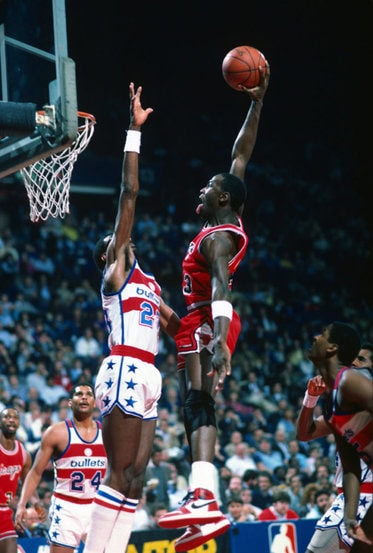
Brad Johnson (Former Nike Basketball Product Line Manager): When the Air Jordan 1 was released to the market, we were on a trip and were so excited.
We walked into a mall and counted 15 different locations with the same shoe all in their window! It was like, ‘Uh oh, what’d we do here?’
Ron Hill (Oversaw Nike Product Merchandising in the ’80s & ’90s): The Air Jordan was the only basketball shoe we could sell.
Dave Siddons: The comparable item was the Tiger Woods red polo. We put that polo in every single store and killed that thing in 10 days.
Everybody wanted it and we had no distribution philosophy around that.
Ron Hill: After [MJ] broke his foot, there was a lot of concern around him coming back. The cushioning became a real concern for him and the feel he wanted. There was an interesting debate internally about investing in Air and validating it in basketball.
The Air Down There
Contrary to popular belief, the original Air Jordan had very little actual Air.
Playing in Converse at North Carolina and adoring Adidas off the court, MJ and most of his peers in the early ’80s were accustomed to cupsole or vulcanized sneakers with next to no cushioning.

For a two-way player like Mike, court feel was at a premium for quick cuts. Because of this, most elite players preferred feeling low within their shoes than wearing that of Air — a new Nike innovation considered unstable by numerous pros.
Internally, execs at Nike struggled to sell endorsed athletes on the benefits of Air when it came to cushioning and long-term health. Recovering from a foot injury, designers attempted to sell MJ on making Air an integral part of his second sneaker.
Brad Johnson: There was a lot of skepticism around Air Force 1. Most of the guys at that time were pretty resistant to the full-length cushioning.
We told them it would be good for them in the long term, but those guys weren’t thinking further ahead than the next season.
Kirk Richardson (Nike’s AF1 Therapist/SMUs at Footlocker in the ’80s): The multiplier of ground impact force for basketball is probably 4x what a runner experiences, so it was not only measurable science-based targets, but the evidence was informing us that we just had to dial this in.
There’s natural skepticism to new technology in any market, but guys like Bruce Kilgore, myself, and others were hearing that Air had significant performance benefits that we just needed time to explain.
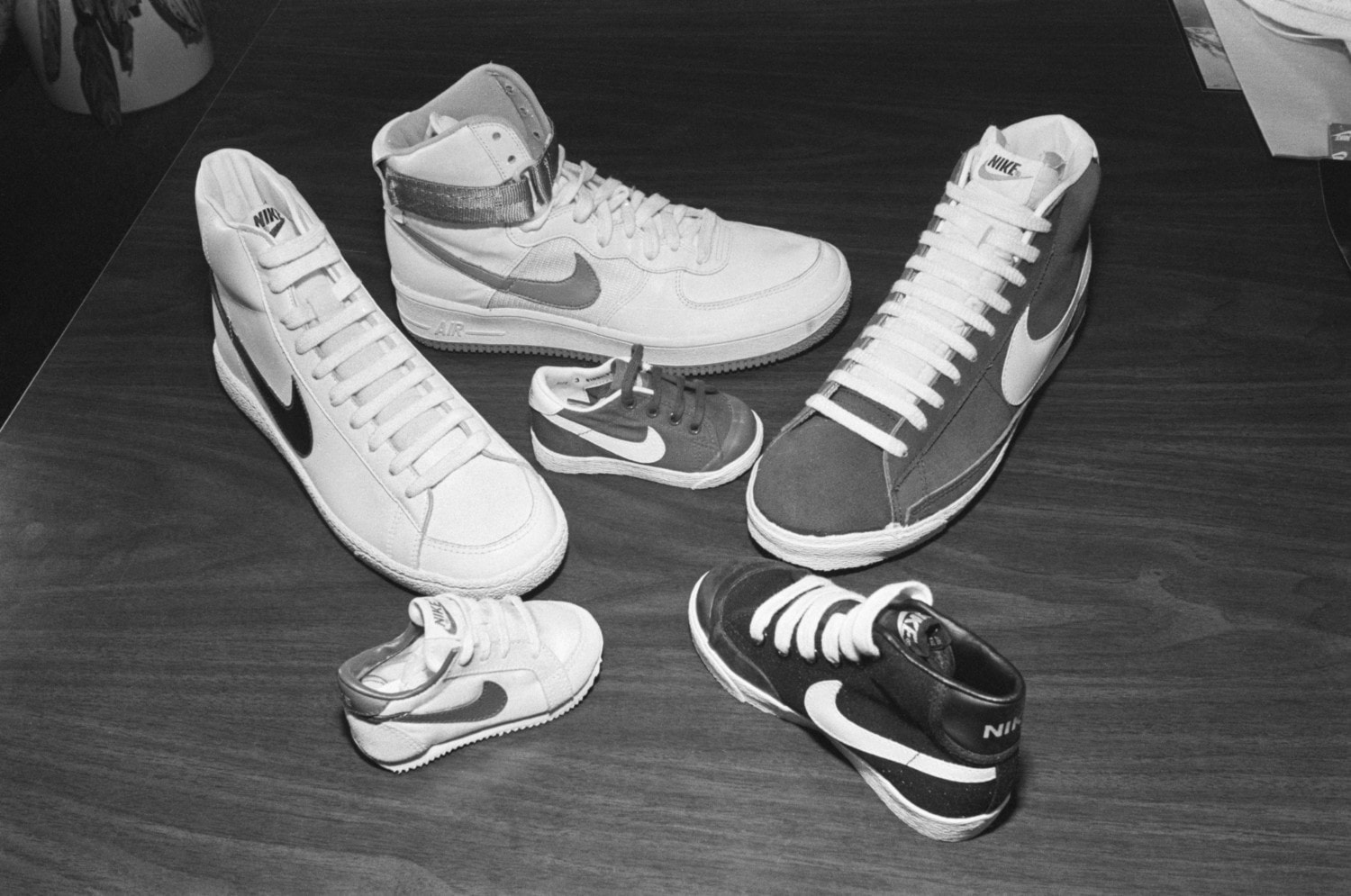
Bruce Kilgore (Footwear Designer, Implemented Nike Air into the Air Force 1): Before the Sports Research Lab, all the innovations were based on perception. It wasn’t until we had the lab that it was perceivable and measurable.
Ron Hill: It had to meet Michael’s needs for performance. There was a style component that Jordans had to have.
Bruce Kilgore: We met with Michael slightly before the 2. I think I got the invite to convince Michael that we had the capabilities to deliver on what he was looking for. From a manufacturing and design credibility perspective I think that’s the only reason I got invited to that.
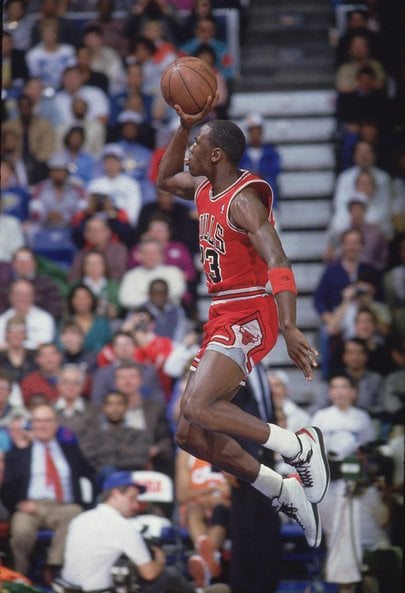
Brad Johnson: In the early time period where Rob and Peter were involved, it was a much more protective element to access the athlete.
Rob Strasser and Peter Moore kind of managed the athlete relationship with David Stern and his agent. Bruce and I got involved, but more on an invite basis.
Kirk Richardson: Rob was an incredibly passionate guy and was very selective as to who was going to intersect with Michael. It was very tight.
Brad Johnson: When the Air Jordan 1 came back, the feedback from [MJ] was he wanted a more stylized shoe and Bruce took that to heart.
Bruce, from a design and performance standpoint, changed the aesthetic of the basketball industry.
Bruce designed the Air Ace, a tennis model, that had different polyurethane compounds for the midsole all done in one mold. Rubber was much better for the basketball court, so we tried to solve that, which is where Bruce’s idea for Italy came about.
Bruce Kilgore: Italy was the solution to the problem because the only way at that time to provide the cushioning and bring the height down was in Italy.
Flying Overseas
From Ferragamo to Gucci, Italy is esteemed with excellence and craftsmanship when it comes to fashion.
In order to make Michael Jordan the first truly stylized, designer basketball shoe, Nike’s top talent had to leave their rainy residence in Oregon to deliver on his second signature sneaker.

This meant mountains of pasta, fine wine, and inspiring scenery. It also meant sky-high expectations when sustaining the growth of a multi-million dollar franchise while protecting the health of their golden goose athlete.
Not only was the Beaverton brand intent on making Michael land softer when he took flight; they were consumed with meeting his measuring stick of looking as fly as possible at all times.
Ron Hill: Michael would go to a game dressed to the nines. He looked like he was going to the Oscars every night. That was part of his persona.
Talking about Italian design? Michael loves Stacy Adams shoes, he must’ve had 50 of them in his closet when we went there. So, the stylized version of the [game] shoe reflected his current style attitude from his tailor to his colors and influences.
Bruce Kilgore: To get this new approach to footwear, we required different manufacturing capabilities. By the Air Jordan 2, we had good injection molding capabilities in Italy.
Mark Parker, myself, and Claudio [Innocente] were sketching stuff up over the course of a couple weeks. Giorgio Franco was the owner of Sport Time [an Italian contract factory for Nike] where we produced the Air Jordan 2. He was their Chief Pattern Engineer based out of Italy.
It was really a wonderful way to work where you could sketch stuff up, have a pattern maker right there to make tweaks, and a palette of materials.
John Barbour (Former Head of Category at Nike Sportswear & Training): Once we saw products coming back from Italy, you were going to get a beautiful stitching job, the edges and shape were immaculate. It was just going to be finished as this beautiful piece of footwear which you always got from Italy.
Bruce Kilgore: There was higher quality leather to choose from. The craft, shape, and fitting of those shoes? That was Claudio [and Giorgio]. The blending of high-quality materials with really good pattern engineering; you really got a superior shoe.

Ron Hill: We learned so much from Reebok about performance leather. We learned about stability and Michael wanted to be lower to the ground, so we worked on that. There was a lot of learning and Michael pushed that learning. He never wanted to look back.
Bruce Kilgore: The past approach was if you wanted more support, you stitched something on the outside. The inside of the shoe was where the support was where the outside of the shoe became the facade.
Brad Johnson: We were always putting stuff on the outside and Bruce was like, ‘Hey, those can be internally engineered so you get the same structure and support but aesthetically the outside is recrafted and rethought.’ It’s a beautiful shoe.
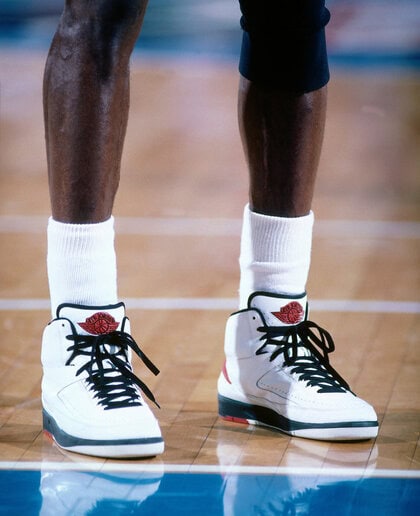
Bruce Kilgore: What’s unique about the Air Jordan 2 is it had a rubber bottom, whereas most shoes had polyurethane bottoms.
I went back to the people in Spain who were making the Air Force 1 and they had developed the rubber formulation and a special primer to treat the rubber outsole, and that was a real breakthrough.
Ron Hill: The finishing of those shoes, the toe profile? That’s part of what Italy brought to the Air Jordan 2.
We wanted Air Jordan to be the pinnacle because Michael was. Not only was he the pinnacle of athleticism, but Michael had a style to him and Bruce went searching for a better solution.
Bruce Kilgore: Rubber production in Spain, polyurethane in Italy, and their mold-making and skill in injection molded parts mashed altogether to make the Air Jordan 2.
Ron Hill: With Mark Parker and the design aid of Italy, it brought that elegance, sense of style, and differentiation. We wanted to position as an aesthetically different brand because Michael was a different athlete. It was gonna be more expensive and it needed to have that element of luxury as you call it, but we would call it style performance.
If it looked like a Nike, we failed.
The Rollout
In November 1986, the Air Jordan 2 released at retail.
Debuted in NBA action by Michael Jordan in the Chicago Bulls‘ season opener in Madison Square Garden, the star shooting guard put on a show, scoring 50 points in a road win over the New York Knicks.
Game 1 of the 1986-87 season forecasted a brighter future than that of the injury-plagued Year Two, with Mike winning his first NBA scoring title by pouring in 37.1 per game while starting all 82 of them.
Maybe there was something to this new Air technology.
As Nike introduced Mike’s new shoe to market — one with no Swoosh on the upper — the idea of luxury basketball imported from Italy meant an entirely new strategy where the sales team was concerned.
Brad Johnson: At that time, Michael had around one million units between men’s, boys, KOs, and infant sizes. It was about 1.2 million units worth of royalties to stay with Air Jordan.
The average shoe at that point in time was about 60,000 or 70,000 units, so it was about 10 to 20x the volume.
Dave Siddons: When we brought out the 2, we had to reset the Jordan in the marketplace. When the 2 came out, I was getting probably 600 pairs to sell to 100 accounts. The 2 was a really important shoe because of how much we oversold the Air Jordan 1.
The Air Jordan 2 was repositioned distribution-wise. That shoe was vital because we began to pull back pairs and began to sell selectively.
The 2 was not available to the masses in terms of retail distribution and that’s the learning from the 1. That set us on a multiple-year effort to clean up distribution because we used to sell everything to everybody.

Jerry Alloco (Distribution at Nike in the ’80s & ’90s/’The Man in The Street’): You’ve gotta realize that back in ’86, there were only a handful of Foot Locker stores. They were getting converted from Kenny’s Shoes then, so there wasn’t the big pen in the industry that could influence product roots.
Ron Hill: Nike competed with Adidas, Converse, New Balance, Pony, and PUMA. We had established a Force line with Air Force, Court Force, and Sky Force.
With Force, we targeted interior players. Michael was our impetus for the Flight collection and he was going to be the Flight Commander.

We’re trying to get slots on a wall, and at that point, we probably sold four or five styles to a [retailer], so the only way to knock off another company was not to create another Force shoe, but another brand.
Falk, Rob, and Peter wanted to create a brand with the Wings on the tongue, which became the identifier for Jordan — which became the Jumpman.
Brad Johnson: Air Jordan was definitely the branding position at that point because it became so successful.
Then every year it came in February and was the pinnacle product for that year. It set the direction for Flight, for Force, for Nike Basketball.
Jerry Alloco: When you have 15,000 stores? It carries a big weight.
Ron Hill: We created a whole business plan to take Jordan out of Flight and it became Air Jordan. That was intentional. Rob said it was so, so it was so.
So, we didn’t have to put a Swoosh on it. We had the Wings, and then it became the Jumpman. This is when we were going into collections with footwear and apparel hookups.
Back in Black?
A core component of the original Air Jordan’s success was the “Banned” narrative.
Leaning into the league fining Michael for wearing Black/Red Air Ship PEs in preseason, Nike sold droves of Black/Red Air Jordan 1s under the impetus that David Stern’s dress code didn’t allow an individual’s shoe colors to clash with that of their teammates.
This was true, as Stern famously threatened to up the ante on each game and even suspend Jordan from play.
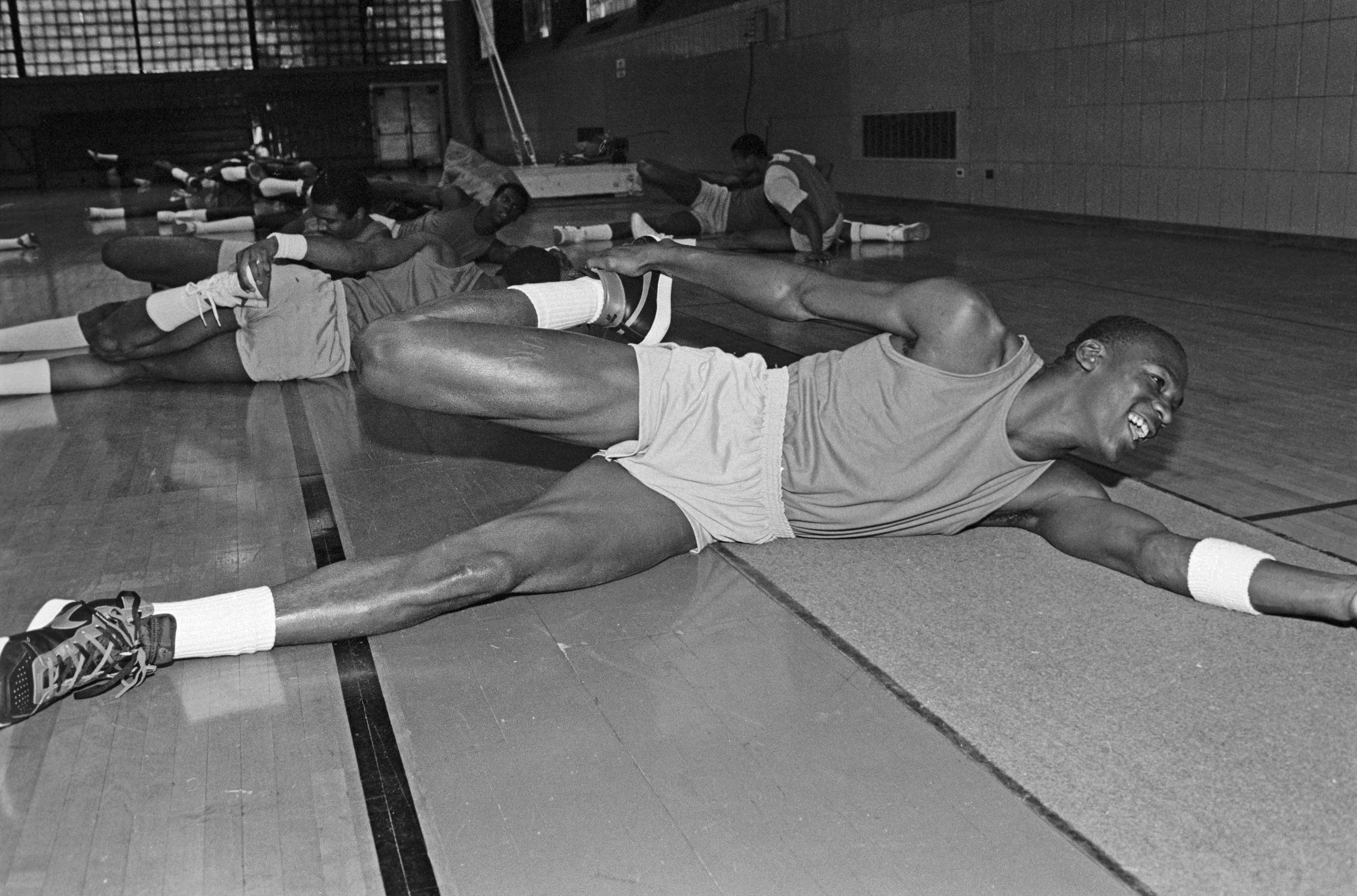
While Nike ate off the idea that Mike was rebellious to wear Black/Red Air Jordan 1s — a pair he only laced in the 1985 Slam Dunk Contest — they ultimately adhered to protocol by placing MJ in white-based sneakers.
This proved true for his sequel which infamously did not carry a black-based original either at retail or on the court.
As history tells, this was a reaction to both Stern and the market.
Tom Amedeo (InStyleShoes Owner/Lifelong Enthusiast): It’s an oddity – it’s the only original Air Jordan to release in four white-based colorways. There should’ve been a black-based Air Jordan 2 originally.
It should have at least been on the drawing board and most people would say that based on the excitement of the Black/Red Air Jordan 1, but we’ve never seen a sketch. We’ve never seen anything.
Dave Siddons: At that time, two colors would’ve forced a buy that [retailers] didn’t want to make.
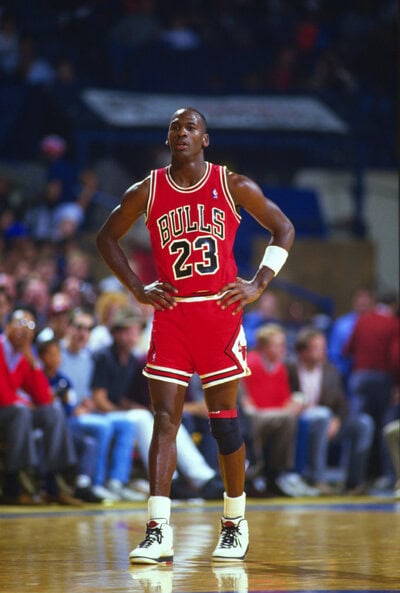
We always talk about design language, and the Air Jordan 2 was a completely new design language for Nike. The way we’re positioning the shoe, one color was sufficient.
Russ Bengtson (Author/Former SLAM & Complex Editor): Black shoes in the mid-’80s were like the Adidas Official — those were referee shoes. As a consumer back then, people were wearing white shoes with color accents.
Dave Siddons: Black was not a significantly important Nike colorway in basketball.
I don’t recall a major volume shoe in black until the Air Bound. The one significant black shoe was the Converse Weapon, which Larry Bird wore.
Bruce Kilgore: The Bulls didn’t have a black uniform then, so there wasn’t a hookup. With Limited Edition, that’s where white-white and black-black came out.
Brad Johnson: At that time, [the market] was about 80/20 white to black. Black was much more associated with football, soccer, and baseball shoes.
The All-Star Game was the one time where the NBA said the colors didn’t have to relate.
The Legacy
In Air Jordan history, hoop highlights and marketing mania positioned the AJ1, AJ3, and AJ11 as best-in-class.
Though each model made the footwear franchise what it is today, the Air Jordan 2 is often overlooked in regard to its impact in building Jordan’s brand — and later the Jordan Brand — as a standalone entity.
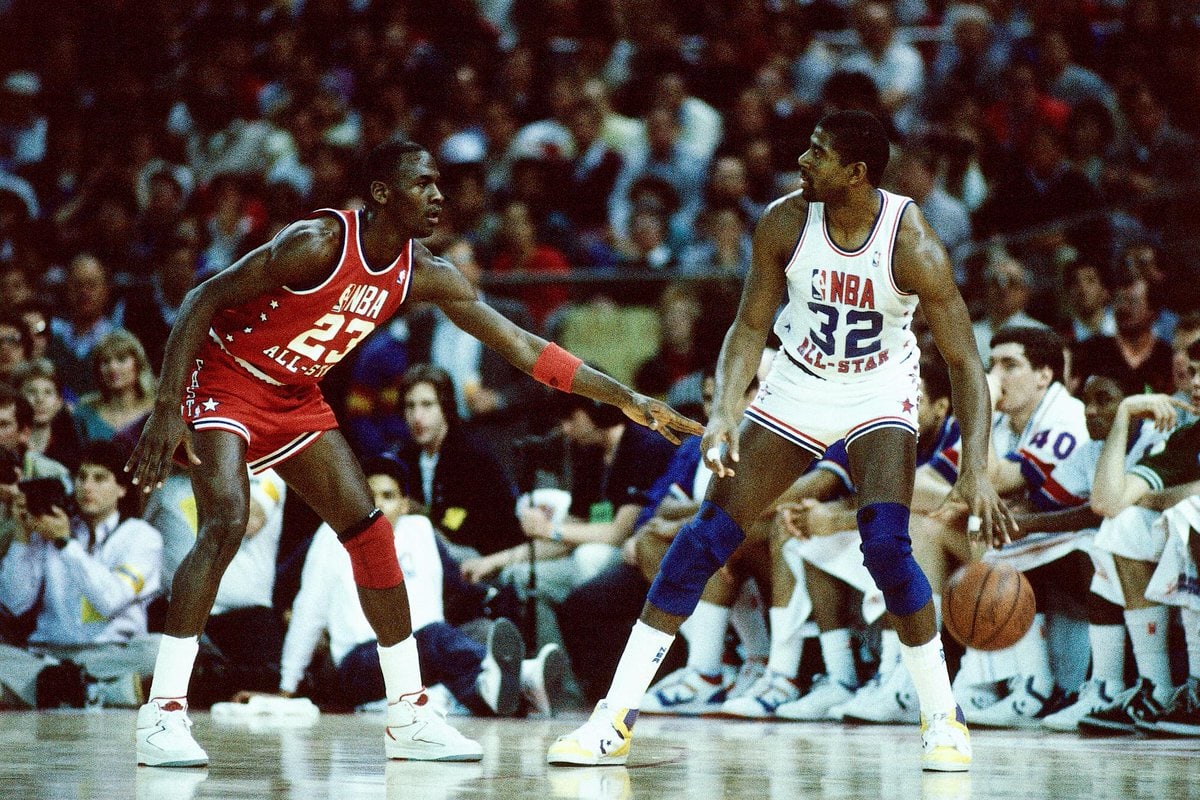
By building a stylized shoe in Italy and subtracting the Swoosh, the creative team at Nike made a definitive Nike that didn’t look like a Nike at all. This polarizing approach makes the model somewhat mysterious (and even plain) to new consumers.
Just the same, it stands as an inflection point for fans and execs that were there since Day 1.
Russ Bengtson: The Air Jordan 2 was the first Air Jordan I ever bought. I would buy the previous Air Jordan when the new Air Jordan came out.
As great as Jordan was, basketball was third [in shoe sales]. Nobody could’ve predicted that Air Jordan would be this transcendent umbrella that would sell more than running and tennis.
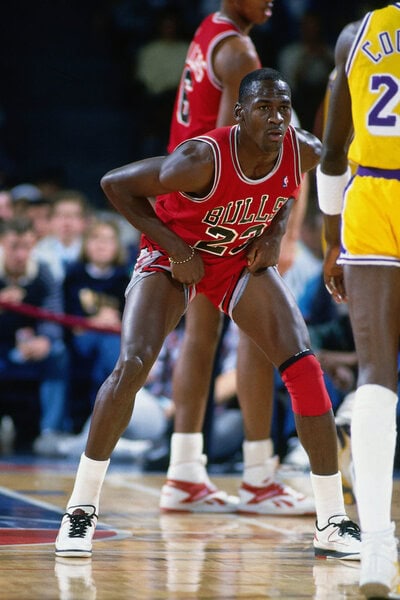
Ron Hill: [In the ’80s] the All-Star Game was the first time we introduced a basketball shoe into the spring. Then, we pushed colors going into the NCAA Tournament, and that’s when the Dunks were introduced.
Our business went up 40%.
Bruce with that Italian style really set the tone for what was going to happen afterward.
Brad Johnson: Michael was the pinnacle athlete. The 2 was engineered for that, but aesthetically, it changed the whole industry.
There was no Swoosh. I recall having a conversation with Bruce that the AirShip and the Air Force 1 had a similar iconic look that visually showcased the performance features.
The 2 changed the dynamic of how the athletes, product teams, and designers spent time.
Peter Moore had a vision for a brand. Peter and Rob were like two peas in a pod and they knew that once we signed Jordan and this started steamrolling that Nike had something really special.
I wouldn’t say there was a vision for a break-up brand, but there was a lot of conversation about the Wings logo and it being an Air shoe.
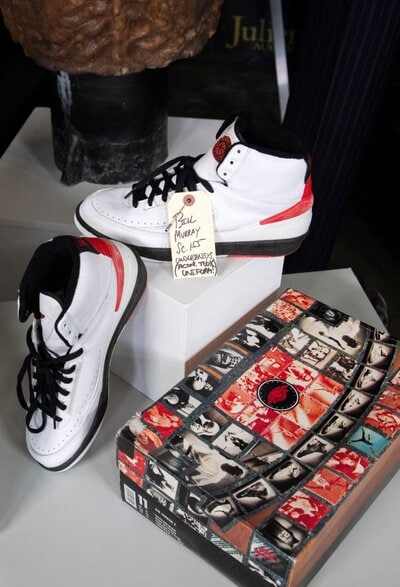
Bruce Kilgore: I think the reason the Swoosh didn’t appear is that Peter Moore was already working on a new branding with a different strategy.
Brad Johnson: When Rob and Peter left Nike in 1986, it opened it up for Tinker Hatfield and the product team to have time and build a relationship.
Tom Amedeo: There’s a direct line from the Air Jordan 2 to the Air Jordan 3. The 3 continues what the 2 did, it just takes it even further.
Brad Johnson: Tinker took it from there, but Bruce started that whole change.
Bruce said, ‘I can build a great performance basketball shoe but it doesn’t have to look like every shoe we’ve made before.’
And that was when he designed the Air Jordan 2.
The Air Jordan 2 was really the change of the paradigm of what a basketball shoe could look like.
Special thanks to Tom Amedeo, Jeffrey “Coach” Tapkas, and The 6453ers.
More Sneaker Oral Histories:
The Nike Air Ship
Cincinnati Basketball’s Air Jordan Era
The “Nerf” Nike KD 4
The “Cool Grey” Air Jordan 11
- Why the New York Liberty Picked the Perfect Time to Pursue a WNBA Dynasty
- How the Washington Nationals Turned Juan Soto Into an All-Star Nucleus
- The Year of Screams: Horror is Dominating the 2025 Box Office
- What’s Really Going on with LeBron James?
- Is Cardi B’s Album Tactic a Smart Business Play or a Streaming Shortcut?